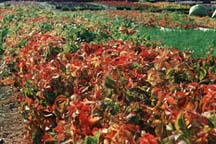 Virginia Creeper Fall
Colors
Virginia Creeper Fall
Colors

 Virginia Creeper Fall
Colors
Virginia Creeper Fall
Colors
Deciduous,
leaves turn bright red in fall, produces
dark blue berries, fast and easy to grow.
The Virginia Creeper is a vine that gets to be 150 ft.
high. The fruit is 1/2 in, wide. The stems are climbing
or sprawling and clinging with tendrils or aerial
thootlets used to cover a large space in a short time.
The leaves are divided into 3 or 5 stalked leaflets.
The leaves 2-1/2 to 6 inches across, which fan out
from center. Leaves turn gold and crimson in fall. The
leaves are green in summer or red in fall. The flowers
are tiny, greenish, clustered; fruits dark blue. They can
be found rich woods, riverbanks, thickets, and field
edges. They are native to an area that includes the northeastern United
States to Florida, Texas
and Mexico. A vigorous grower, runners root along the ground as they
travel to create a dense
cover. It blooms in July and August. They are cousins of the grape.
They climb in two ways; by
twining tendrils, and by modified roots equipped with adhesive pads
that cling to walls and other
surfaces. It produces colorful blue fruits that attract birds. They
are poisonous to humans, yet the
fruits of the Virginia Creeper are an important fall and winter food
for many songbirds and other
wildlife. The group includes Boston Ivy, which, despite its name, was
imported from Asia. It is
widely cultivated in the United States, producing a intimate wood-land
feeling, often climbing on
fences, masonry walls or trellises as a fast summer cover. Often used
as a random ground cover
with other plants around the foundation of a structure or as a garland
up a tree or post. It is
sometimes invasive, it can cover windows and other openings. Sometimes
attacked in summer by
grape leaf skeletonizers. It is occasionally bothered by root knot
nematodes, powdery mildew and
Texas root rot.